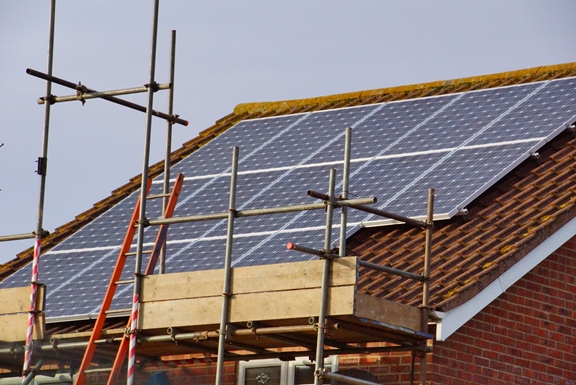 This week we have an interesting guest post from Elizabeth Eckhart. Elizabeth is a freelance blogger and aspiring author. Her writing interests include home improvement, the energy crisis, and in general spreading ways to improve the world around her. I got to say when I first heard the idea I replied back that sure I would be glad to look at it but I wasn’t sure it would fly. Well I got to say she did a great job on exploring the options out there which includes a ton of useful links. So with no further ado…
This week we have an interesting guest post from Elizabeth Eckhart. Elizabeth is a freelance blogger and aspiring author. Her writing interests include home improvement, the energy crisis, and in general spreading ways to improve the world around her. I got to say when I first heard the idea I replied back that sure I would be glad to look at it but I wasn’t sure it would fly. Well I got to say she did a great job on exploring the options out there which includes a ton of useful links. So with no further ado…
With energy prices, deregulation, and climate change all in the news, homeowners looking for the best options for their energy needs have a lot of things to consider. Aside from saving money, many of us are increasingly interested in doing what we can to use renewable, “green” energy sources for our electricity if possible, but knowing how to go about finding these options can be difficult, particularly in states that haven’t deregulated their energy markets. So where should you begin looking for ways to have your home’s electricity come from renewable sources, such as hydro, wind, solar, and even lesser known options such as geothermal or biomass, instead of the far more widespread but “dirtier” fossil fuels?
For some homeowners who use little energy or are located in prime locations, going completely off-grid regarding power, The HTRC has an excellent piece on this which could be an option for some. But that article also does an excellent job of explaining the downside to many of the renewable energy sources. Wind and solar, for example, are unreliable and dependent on weather conditions. Wind, especially, can result in sudden stops in energy flow. Hydro, a more reliable source, and currently a provider for over 20% of the world’s energy (and over 60% of renewable sources), is expensive to build, requires an abundance of regulatory hoops to jump through, and, on top of that, doesn’t have much in the way of future capacity expansion because most of the natural spots to create hydro energy are already being used to their fullest capacity.
 Both urban and rural homeowners would also have to factor in installation costs of any equipment required to make use of alternative energy sources. Solar panels, for instance, still require a sizeable investment to get up and running (though these prices have been going down lately). Buying household products that are use less power and use it more efficiently (whether it be through sites like GreenCupboards, or items that possess an EnergyStar rating) is still a good way to reduce your household’s energy costs and impact on the environment.
Both urban and rural homeowners would also have to factor in installation costs of any equipment required to make use of alternative energy sources. Solar panels, for instance, still require a sizeable investment to get up and running (though these prices have been going down lately). Buying household products that are use less power and use it more efficiently (whether it be through sites like GreenCupboards, or items that possess an EnergyStar rating) is still a good way to reduce your household’s energy costs and impact on the environment.
For those who don’t have the funds to outfit their home with solar panels, a simple call or visit to their electricity provider’s website might be beneficial. Most should have some variation of green energy plan. Alabama Power, for example, has several hydroelectric generating plants on the rivers Tallapoosa and Coosa, and Black Warrior, as well as nuclear and cogeneration (thermal) plants in various parts of the state. In order to support the use of renewable energy sources, customers can participate in a Renewable Energy Rate. The customer can then choose how many hour blocks they would like to purchase per month, which results in more renewable energy sources being put into the state’s grid.
For deregulated states, there are even more options. In midwest states such as Illinois and Ohio, sites like Power2Switch.com can help compare energy rates, as well as pick an amount of energy service to be provided through renewable sources. Likewise, southern deregulated states can visit energy comparison sites like www.TexasElectricityProviders.com (Texas), Energize Connecticut (Connecticut) and similar state-based informational sites in order to peruse various retailers and their green energy plans.
Most retailers will have multiple options regarding both the percentage of a customer’s energy comes from renewables and how the renewable energy is used. For some, the retailer will ensure that a part of, or even 100% of a home’s energy is produced from renewable sources. For others, the company won’t guarantee that the energy purchased from a renewable source will be the same energy coming into a specific residence, but purchasing renewable energy will at least guarantee that the equivalent of a home’s usage amount is integrated into the overall grid.
Many energy providers, especially when offering plans to businesses, will discuss purchasing RECs, or renewable energy certificates. RECs can be purchased by themselves, or purchased along with physical electricity from a utility service provider. RECs serve as a type of currency in the energy market, and since they are monitored and verified, both residents and businesses can ensure that electricity generated on their behalf was done using renewable energy sources. RECs are especially important for residents whose local electricity provider offers few or no green energy options. Though energy providers have progressed to an extent, not all electricity providers offer options to select renewable resources. RECs can be purchased separately from an electricity provider, and represent a specific amount of avoided greenhouse gas emissions. Once a buyer makes an environmental claim, done through a tracking system in their name, the REC is retired and no other person or business can lay claim to that specific environmental benefit.
For now, until technology catches up to the requirements of current machinery and technology necessary for both businesses and homes, RECs offer a viable option to reduce a home’s carbon footprint. Even the corporate internet giant Google uses this technique; just recently, on September 17th, Google purchased the entire 240-megawatt output of a wind farm outside Amarillo, Texas. Google’s data center can’t consume wind power directly since, as mentioned before, wind power is relatively unreliable, and Google can’t risk having their network crash because of a day without breeze. Instead, the company will retire the 240 renewable energy certificates and effectively reduce Google’s carbon footprint to a minimum. The tech giant made similar deals in Iowa and Oklahoma.
For small businesses and homeowners, RECs and green energy plans can work to supplement any energy efficient steps already being taken. Proper home insulation and other energy reduction tips can and should be implemented in order to reduce both energy bills and carbon emission, but for those looking to take a step further, at a time when renewable energy needs a kick start, contacting energy providers and chipping in toward green power is a worthy investment.

Thanks for posting this useful information. It help me alot.
My pleasure & I am pretty sure Elizabeth will second that. Many thanks & here is to a great year
Thanks for posting this useful information. It help me alot.
My pleasure & I am pretty sure Elizabeth will second that. Many thanks & here is to a great year